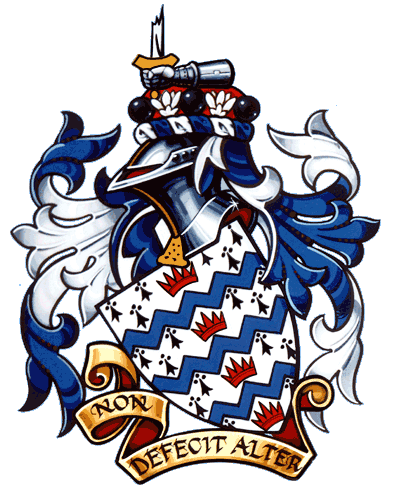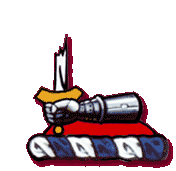
The family crest, a broken sword held in a mailed gauntlet - indeed the whole 'crested helmet' and the family motto to which it refers (see the motto below) - was awarded to one of our earliest recorded ancestors, John fitzPeter de Staynford, by King Edward III in 1346 for defending his son, The Black Prince, at the Battle of Crecy.
The 'wreath and circlet'. 'A Wreath Argent (white) and Azure (blue) within a Circlet of Gunstones (canon balls) and Lotus Blossoms Argent a mount Gules (red)'. The canon balls and lotus blossoms are indicative of military and civilian service in the tropics. The red colour of the cushion (a 'mount gules') also implies military service.
The crested helmet, awarded to John de Staynford by Edward III, enabled him - a mere Man-at-Arms - to take part now in tournaments. The helmet depicted here is in fact one of the grandest designs of 'jousting-helm' of the 15th Century.
The family arms. The 'blazon of arms' reads: 'Ermine (meaning: a white background with an ermine decoration) three Bars Indented Azure (blue zig-zag bands) between four Eastern Crowns in pale (on the shield centreline) Gules (Red).' The red, pointed Eastern crowns refer to Stainforth service in India and the Far East.
The motto 'Non defecit alter' means 'not found wanting a second time'. The family tradition is that Edward III, in choosing this motto, was referring to an earlier failing by Leuric (a very distant Stainforth ancestor) at the battle of Hastings in 1066, which had now finally been redeemed by John de Staynford at Crecy some 280 years later. 'Defecit' for 'deficit' appears to be a Norman French corruption and dates from a 1901 revision of the family arms by a Belgian branch of the family.

